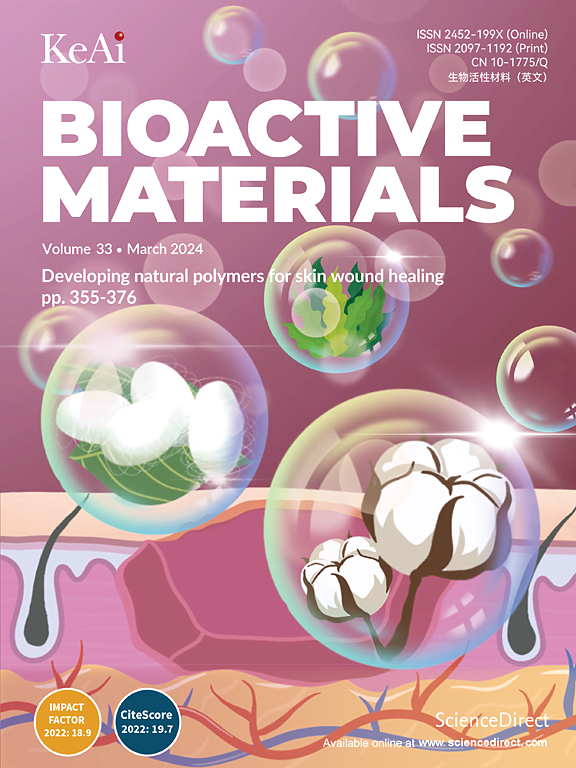d -对映体肽对不同恢复阶段口腔生物膜代谢、多样性和组成的影响
IF 18
1区 医学
Q1 ENGINEERING, BIOMEDICAL
引用次数: 0
摘要
细菌在根管系统的持续存在是复发性根尖牙周炎的主要原因。残留细菌对不断变化的环境条件的适应性是生物膜的关键生存策略,往往导致根管治疗失败。DJK-5是一种具有蛋白酶抗性的广谱d对映体肽,可降解或阻止鸟苷五磷酸和四磷酸的积累,而鸟苷五磷酸和四磷酸对生物膜的形成至关重要。我们评估了主要抗菌药物和营养条件对口腔生物膜的恢复、代谢、多样性和组成的影响,并研究了这些因素在再次暴露时如何影响DJK-5和氯己定(CHX)的疗效。原生灌溉和养分条件显著影响生物膜的恢复、代谢活性、多样性和组成。与营养丰富组相比,营养缺乏组的生物膜恢复速度较慢,营养可利用性对生物膜多样性和组成的影响最大。水组和DJK-5组生物膜多样性趋势相似,CHX组生物膜多样性总体较低。结果表明,原生灌溉和养分条件显著影响生物膜的组成、多样性和恢复。然而,这些变化并没有影响DJK-5在重新暴露回收的生物膜时杀死生物膜微生物的有效性。本文章由计算机程序翻译,如有差异,请以英文原文为准。

Primary and Re-exposure effects of D-enantiomeric peptide on metabolism, diversity, and composition of oral biofilms at different stages of recovery
The persistence of bacteria in the root canal system is the primary cause of recurrent apical periodontitis. The adaptability of residual bacteria to changing environmental conditions is a key survival strategy of biofilms, often leading to endodontic treatment failure. DJK-5 is a protease-resistant, broad-spectrum D-enantiomeric peptide that degrades or prevents the accumulation of guanosine penta- and tetraphosphates, which are important for biofilm formation. We evaluated the effects of primary antimicrobial agents and nutrient conditions on the recovery, metabolism, diversity, and composition of oral biofilms, and investigated how these factors affect the efficacy of DJK-5 and chlorhexidine (CHX) during re-exposure. Primary irrigants and nutrient conditions significantly influenced biofilm recovery, metabolic activity, diversity, and composition. Biofilm recovery was slower in nutrient-poor groups compared to nutrient-rich ones, and nutrient availability had the greatest effect on shaping both the diversity and composition of the biofilms. Water and DJK-5 groups showed similar biofilm diversity trends, while CHX generally led to lower diversity. Results indicate that primary irrigants and nutrient conditions significantly impact biofilm composition, diversity, and recovery. However, these changes did not compromise DJK-5's effectiveness in killing of biofilm microbes during re-exposure of recovered biofilms.
求助全文
通过发布文献求助,成功后即可免费获取论文全文。
去求助
来源期刊

Bioactive Materials
Biochemistry, Genetics and Molecular Biology-Biotechnology
CiteScore
28.00
自引率
6.30%
发文量
436
审稿时长
20 days
期刊介绍:
Bioactive Materials is a peer-reviewed research publication that focuses on advancements in bioactive materials. The journal accepts research papers, reviews, and rapid communications in the field of next-generation biomaterials that interact with cells, tissues, and organs in various living organisms.
The primary goal of Bioactive Materials is to promote the science and engineering of biomaterials that exhibit adaptiveness to the biological environment. These materials are specifically designed to stimulate or direct appropriate cell and tissue responses or regulate interactions with microorganisms.
The journal covers a wide range of bioactive materials, including those that are engineered or designed in terms of their physical form (e.g. particulate, fiber), topology (e.g. porosity, surface roughness), or dimensions (ranging from macro to nano-scales). Contributions are sought from the following categories of bioactive materials:
Bioactive metals and alloys
Bioactive inorganics: ceramics, glasses, and carbon-based materials
Bioactive polymers and gels
Bioactive materials derived from natural sources
Bioactive composites
These materials find applications in human and veterinary medicine, such as implants, tissue engineering scaffolds, cell/drug/gene carriers, as well as imaging and sensing devices.
 求助内容:
求助内容: 应助结果提醒方式:
应助结果提醒方式:


